| Yeast |
“Now I’m going to visit Junmai Kimoto CLASSIC. (knocks) Hello, here is Yeast!” |
| Junmai Kimoto CLASSIC |
“How are you, Yeast, please come in.” |
| Yeast |
“Even within Daishichi, which respects tradition, you are called ‘Classic’ – it makes me nervous to think how old-fashioned and strict you must be!” |
| Junmai Kimoto CLASSIC |
“Relax! It’s true I have a classical side, I was born in 1999. That was the last year of the century, I seem to have been a product Daishichi wanted to bring out as a sort of conclusion.” |
| Yeast |
“Conclusion? What do you mean?” |
| Junmai Kimoto CLASSIC |
“I’m so to speak the representative of the good old values. Technology has advanced a lot in the 20th c., but it was also the age of mass production. A strong preference came up for sake that was dry and crisp, easy to drink and easy to understand. As a way of summing up the values our ancestors deemed important, Daishichi wanted to create a classical and noble sake.” |
| Yeast |
“I see! You have a rich and deep taste, and after aging a mellow deliciousness. For Daishichi, that is the ‘royal way’ of a fermented beverage.” |
|
 |
| Junmai Kimoto CLASSIC |
“Yes, indeed. That’s something that will not succeed if the taste is insufficiently big-boned, or if the sake is not aged for several years. The master brewers of the past could accomplish that, but it’s very difficult to recreate that today.” |
| Yeast |
“But isn’t today’s technology on a higher level?” |
| Junmai Kimoto CLASSIC |
“One could say that, but the level of refinement that is demanded today is also again different. The greatest effort during the brewing is, while drawing out such a rich umami, to avoid dullness or off-tastes. For that we need yeast that keeps in good health even during a long and rich fermentation process and that is powerful and clever!” |
| Yeast |
“So I have to do my best! By the way, on the box of the CLASSIC are two designs like heraldic emblems.” |
| Junmai Kimoto CLASSIC |
“The top one, an emblem of two lions, symbolizes the past and the present. The one below that, a lyre drawn in Greek style, symbolizes the harmony between heaven and earth. You could also say, between ideal and reality. We, who want to bring the tradition to life in the present, must transform the ideal into reality.” |
| Yeast |
“That’s exactly the philosophy of Daishichi! I didn't know these emblems carry such a deep meaning. By the way, to which dishes do you fit?” |
| Junmai Kimoto CLASSIC |
“Let’s hear your ideas, and try to be unconventional!” |
| Yeast |
“Many dishes suit to such a deep and rich taste… Such as hot pot with oysters, juicy broiled beef round, and duck meat stew, shabu shabu with sesame sauce, and gomadofu…. ” |
| Junmai Kimoto CLASSIC |
“You come up with a lot of delicious dishes. I have only one wish: drink me at room temperature or heated, both as nurukan and atsukan. ” |
| Yeast |
“You were created on behalf of the fans of Junmai Kimoto. That calls up the image of a deep sake only fit for fans, but in fact you are also popular abroad.” |
| Junmai Kimoto CLASSIC |
“I am different from festive ginjo sake, but I am often put on the table instead of high-quality, dry white wine. And I also fit very well to cheese.” |
| Yeast |
“Classic, you are not a revival of the past, but Daishichi’s sake of today! Do your best!” |





